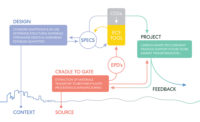Creators of the free-to-use Embodied Carbon in Construction Calculator have added several features since the tool’s release last November. And more are coming, says EC3’s developer. Many of the enhancements are in response to requests from users of the first digital aid to estimate embodied carbon in building production.
EC3’s improvements are in part based on feedback from 470 of the more than 6,500 individuals who have downloaded the tool. “This is a user-centered tool,” says Phil Northcott, founder of EC3’s software developer, C-Change Labs.
Northcott also is one of four founding board members of Building Transparency (BT), a new nonprofit created to host EC3, incubated by the Carbon Leadership Forum (CLF) at the University of Washington. One of BT’s main messages to those involved with building supply is that EC3 “is your tool not ours,” says Northcott.
An architect preparing a report for the LEED 4.1 low-EC construction pilot credit inspired one change. For the LEED submission, the architect needed to detail the material baselines and selected materials in Excel format. EC3 helped out. “We updated the download format to include the required information and added a custom graphic” with only LEED credit materials, says Northcott.
In another case, an interior design firm wanted to show a client how supplier choice would affect the project’s climate change impact. This was difficult to do with the many different brands of the product, he adds.
After a review with manufacturers and BT’s pilot EC3 users, “we added the ability to create this graph for any EC3 search,” says Northcott.
Benchmark, Assess, Reduce
EC3 is an open-access tool to help benchmark, assess and reduce EC. The tool uses building material quantities from construction estimates and/or building information models. EC3 works with Autodesk’s BIM 360 software. Plans are for the tool to interface with other BIMs, such as Tally.
At the core of EC3 is the first database of digitized environmental product declarations. EPDs provide quantified environmental data for a product, including the global warming potential from greenhouse gases emitted during building material extraction, transport, manufacturing and delivery to the jobsite.
EC3 contains 26,000 digitized EPDs from 789 plants in North America and Europe, owned by 293 different manufacturers.
While digitizing product-specific EPDs, which typically arrive in PDF format, C-Change found at least a dozen with major errors, says Northcott. The errors are reported to the supplier’s program operators.
There are 16 material and product categories in the tool. A new category is data cabling. Insulation has been expanded and reorganized. And flooring has been updated.
The tool allows owners, green building certification programs and policymakers to assess supply chain data to create EC-reduction requirements for building teams. Compliance support for state and local clean-climate policies and green-building certification compliance beyond LEED is coming soon. EC3 already has a filter for Buy Clean California compliance.
The initial developers of EC3 became the catalysts for BT, which is funded by industry sponsors and philanthropies. “There is no changing of the guard now because we need continuity,” says Stacy Smedley, BT’s chair, a founding board member and executive director for one year, on loan from Skanska USA Building, where she inspired the creation of EC3.
The BT board includes representatives from Salesforce, Google, Amazon, Microsoft, Facebook and flooring maker Interface Inc. The other two founding board members are CLF director Kate Simonen, also BT’s vice chair, and Don Davies, president of structural engineer Magnusson Klemencic Associates.
BT’s goal, as part of a larger effort to reduce the negative environmental consequences of building construction, is “to scale up” EC3’s impact, says Simonen.






Post a comment to this article
Report Abusive Comment